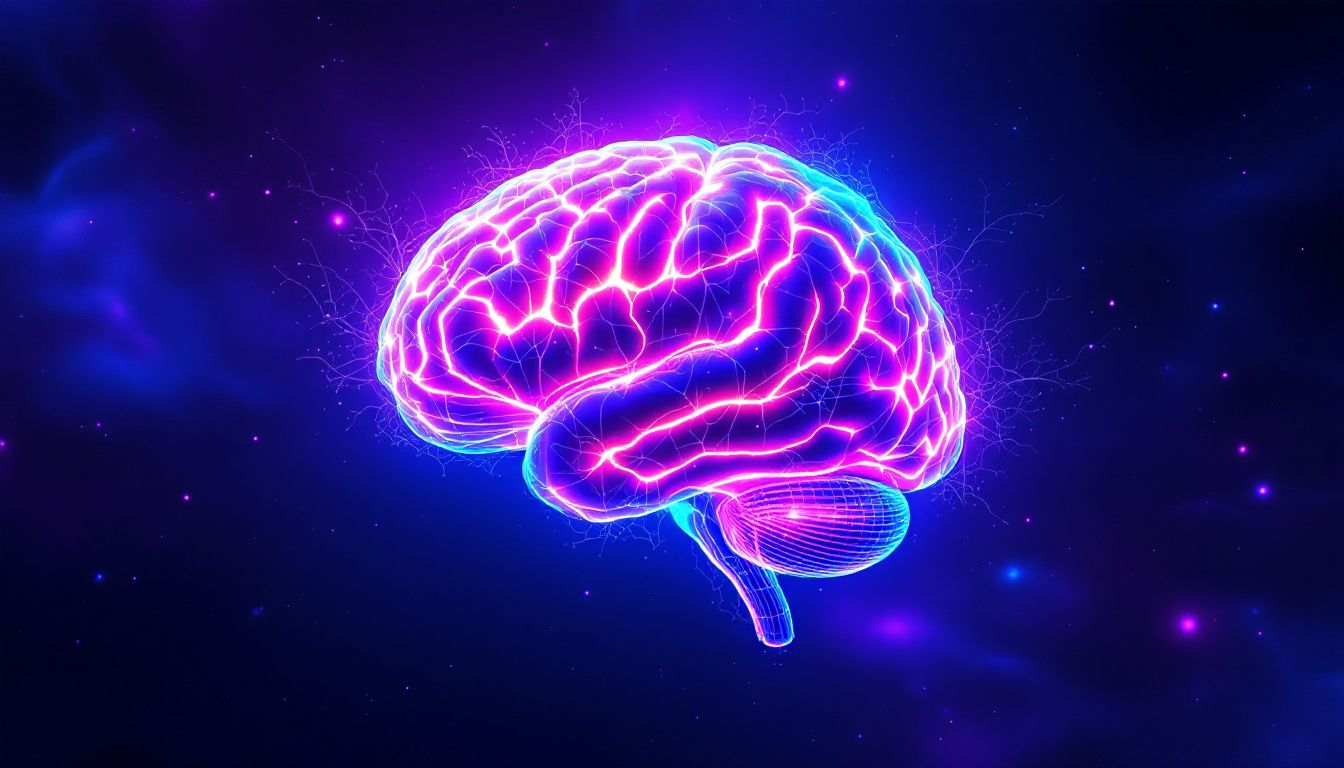Binaural beats are auditory illusions formed in the brain when two slightly different frequencies are played in each ear. This phenomenon can align brain waves with the beat frequency, offering potential benefits like improved mental clarity and relaxation. In this article, we’ll explore how binaural beats work and the top benefits they provide.
Key Takeaways
-
Binaural beats are created when two tones of slightly different frequencies are played in each ear, leading to unique auditory experiences that can influence mental states.
-
Listening to binaural beats can enhance cognitive functions, improve emotional states, and aid in relaxation and sleep, with specific frequency ranges targeting different mental states.
-
Research on binaural beats presents mixed results regarding their efficacy, highlighting the need for standardized methodologies in studies to validate their benefits and applications.
Understanding Binaural Beats
Binaural beats are an auditory illusion created by the brain when two tones of slightly different frequencies are heard simultaneously. This unique phenomenon occurs when each ear receives a different frequency, which the brain perceives as binaural auditory beats, a single, unified tone.
Imagine listening to a tone of 300 Hz in your left ear and a tone of 310 Hz in your right ear. The brain, tasked with processing these frequencies, interprets the difference between them, creating the perception of a third tone—a binaural beat at 10 Hz.
This auditory illusion is not just fascinating; it’s the cornerstone of auditory beat stimulation and binaural beat therapy, unlocking various mental and emotional benefits.
The Science Behind Binaural Beats
The production of binaural beats hinges on a specific auditory phenomenon. When two tones with frequencies lower than 1,500 Hz and differing by no more than 40 Hz are played in each ear, the brain interprets these as a unique auditory beat. This auditory phenomenon occurs because the superior olivary complex in the brain stem processes sounds from both ears, enabling the creation of binaural beats.
The brain perceives these slightly different frequencies as a single tone, leading to what is known as the frequency-following effect. This means that the brain’s electrical activity synchronizes with the frequency of the binaural beat, promoting enhanced synchronization of neuronal oscillations.
Interestingly, binaural beats stimulate brain activity in a way that can lead to various mental states. Whether you’re aiming to relax, focus, or meditate, binaural beats offer a powerful tool for brainwave entrainment, allowing the brain to align with the desired frequency.
Types of Binaural Beats
Binaural beats come in different types, each associated with specific frequency ranges and mental states. Delta waves, ranging from 0.5 to 4 Hz, are linked to deep sleep and relaxation. When you need a restful night’s sleep or deep relaxation, delta binaural beats can be incredibly effective.
Theta waves, between 4-8 Hz, promote deep relaxation and creativity. Theta pattern binaural beats, specifically in the 4–7 Hz range, can enhance meditation, creativity, and facilitate REM sleep. If you’re looking to dive into a creative project or deepen your meditation practice, theta binaural beats are your go-to.
Alpha waves, in the 8-14 Hz range, occur during relaxed states such as meditation and can enhance relaxation and focus while reducing stress. On the other hand, beta waves, ranging from 14-30 Hz, are linked to heightened alertness and problem-solving capabilities.
Depending on your needs—whether it’s relaxation, creativity, focus, or alertness—there’s a specific type of binaural beat to match.
Effects of Binaural Beat Stimulation on the Brain
Binaural beat stimulation has a profound effect of binaural beat on the brain responses, aligning its activity with the frequency of the beats. This phenomenon, known as the frequency-following effect, allows the brain to synchronize its electrical activity with the binaural beats. This alignment can lead to significant changes in how we think and feel.
Increasing the strength of certain brain waves, binaural beats enhance cognitive functions, improve emotional states, and affect physical sensations. Enhance EEG power, boosting cognitive performance, and modulating emotional arousal, the effects of binaural beat therapy are both wide-ranging and impactful.
Enhancing EEG Power
Research has shown that binaural beats can amplify specific brain wave patterns in EEG readings, particularly in frequencies associated with enhanced cognitive performance. This process, known as brainwave entrainment, allows the brain to synchronize with the frequency of the binaural beat, potentially influencing mental states.
Binaural beat stimulation can lead to notable changes in EEG parameters, including variations in power across different frequency bands. This means that listening to binaural beats can impact both the amplitude and frequency of brainwave oscillation, leading to enhanced cognitive performance and mental clarity.
For example, delta waves, ranging from 1-4 Hz, are associated with deep sleep and healing processes. By enhancing these brain wave patterns, binaural beats can facilitate deeper, more restorative sleep and improved overall well-being.
Cognitive Enhancement
Cognitive enhancement is one of the most compelling benefits of binaural beats. Studies indicate that listening to binaural beats may lead to improved memory recall and increased attention span during cognitive tasks. Specific frequencies of binaural beats have been linked to improvements in tasks requiring concentration and detailed attention.
Gamma waves, which exceed 30 Hz, are particularly effective in facilitating cognitive enhancement and detailed attention. By aligning brain activity with these frequencies, binaural beats can enhance cognitive functions and improve performance in various tasks.
However, it’s important to note that evidence supporting cognitive improvements from binaural beats remains mixed, with some studies reporting no enhancement in memory or attention. While emerging studies suggest the potential of binaural beats in enhancing cognitive functions, further research is needed to draw definitive conclusions.
Emotional Arousal and Mood States
Binaural beats have the potential to influence emotional states, potentially reducing anxiety and improving mood. Listening to binaural beats can modulate emotional arousal, affecting both subjective and physiological responses, highlighting the effect of binaural beats.
Binaural beats therapy is recognized for effectively managing anxiety and stress. Enhancing relaxation and mental clarity, binaural beats serve as valuable tools in therapeutic settings, aiding in anxiety reduction and promoting well-being.
However, findings on the effects of binaural beats on emotional states suggest inconsistencies, with some studies indicating minimal impact on anxiety levels. Despite these mixed results, binaural beats therapy continues to be utilized to enhance mental health and emotional well-being.
Practical Applications of Binaural Beats Therapy
Binaural beats therapy offers practical applications for improving various aspects of life, from managing pain to enhancing sleep quality and achieving meditative states. This section provides actionable insights into how binaural beats can be used in everyday life to promote mental and physical well-being.
Administering binaural beat therapy typically involves listening to audio recordings through stereo headphones, allowing each ear to receive different frequencies and creating the desired binaural beat effect.
Pain Perception and Management
Binaural beats have shown potential in reducing pre-operative anxiety in patients, with some studies indicating significant decreases in stress levels. This makes binaural beats a valuable tool in medical settings, particularly for patients undergoing general anesthesia.
However, some studies suggest that the effects of binaural beats may diminish over time, indicating a potential need for ongoing exposure to maintain benefits. This highlights the importance of integrating binaural beats into regular routines for sustained pain management and anxiety reduction.
Improving Sleep Quality
Binaural beats operating in the delta frequency range (0.5–4 Hz) are associated with deeper, dreamless sleep phases. By promoting deeper sleep and relaxation, delta binaural beats can significantly enhance sleep quality and overall well-being.
Incorporating binaural beats into your bedtime routine can help you achieve faster sleep onset and enhance overall sleep quality. Listening to binaural beats before bed can significantly decrease the time it takes to fall asleep and improve the quality of sleep.
Selecting the appropriate frequency for binaural beats, such as delta for sleep or alpha for relaxation, is crucial for maximizing their effectiveness. Choosing the right frequency tailors your binaural beat experience to your specific needs, be it better sleep, relaxation, or focus.
Meditative State Induction
Binaural beats can be effectively used during various activities such as studying or meditating to enhance focus and relaxation. Integrating binaural beats into meditation practices allows individuals to achieve deeper relaxation and heightened awareness.
Listening to binaural beats can be likened to meditation, where relaxation and being present is essential for effectiveness. Binaural beats enhance the meditative experience, helping individuals reach a deeper state of mindfulness and tranquility.
Whether you’re a seasoned meditator or just starting, incorporating binaural beats into your practice can elevate your meditation sessions, making them more profound and rewarding.
Research and Evidence Supporting Binaural Beats
The efficacy of binaural beats has been the subject of numerous studies, resulting in a mixed body of empirical evidence. Some research supports the brainwave entrainment hypothesis, indicating significant impacts on mental health and cognitive functions, while other studies contradict these findings.
Current research demonstrates varied outcomes regarding the effects of binaural beats on brainwave entrainment, highlighting the necessity for clearer and standardized methodologies. Despite these inconsistencies, the potential benefits of binaural beats continue to attract scientific interest and warrant further exploration.
Meta-Analysis Findings
Meta-analyses suggest that binaural beats may have a significant impact on mental health and cognitive functions. For instance, a meta-analysis of 22 studies found that binaural beats can significantly reduce anxiety and improve pain perception.
However, critics argue that the existing research on binaural beats is often small-scale and lacks rigorous controls, which questions the reliability of some findings. This underscores the need for more robust and well-controlled studies to validate the efficacy of binaural beats.
Limitations and Criticisms
One significant criticism of binaural beat research is the diverse methodologies used, which impede the comparability of results across studies. A systematic review revealed that out of 14 studies, only five showed effects consistent with the brainwave entrainment hypothesis, while eight showed contradictory results.
These inconsistencies in findings stem from variability in experimental designs, participant demographics, and methods of binaural beat implementation. Standardized methodologies and more structured studies are needed to enhance the reliability of binaural beat research.
NeuroImmerse: The Power of Binaural Beats to Transform Your Brain
NeuroImmerse takes immersive therapy to the next level by incorporating evidence-based binaural beat technology into its 10 to 30-minute daily exercises. By using sound waves and binaural auditory beats, NeuroImmerse helps synchronize the brain to achieve states of focus, relaxation, or emotional resilience. Binaural beat audio works by delivering two tones—each played in a different ear—via headphones, creating a frequency difference that the brain perceives as a single tone. This phenomenon stimulates specific areas of the brain and encourages neuronal pathways to strengthen and adapt.
Built on groundbreaking insights from frontiers in human neuroscience, NeuroImmerse combines binaural beats with binaural stimulation and evidence-based treatments. Whether you’re looking to boost your mood, improve focus, or fall asleep more easily, these sessions are tailored to align with the brain’s natural rhythms. Simply wear headphones, and let NeuroImmerse guide you into a world where sound waves and pure tones unlock the brain’s ability to grow, heal, and thrive.
Why NeuroImmerse Is the Ultimate Tool for Binaural Beat Therapy
Binaural Beats seem like a simple concept, but with NeuroImmerse, their potential is amplified to deliver life-changing results. Each session uses carefully calibrated two frequencies—one in the left ear and one in the right ear—to create a binaural auditory beat that optimizes brain performance. The frequency difference between the two tones encourages brain synchronization, promoting states of calm, focus, or emotional clarity depending on the session’s design.
NeuroImmerse harnesses these principles with binaural beat audio to support evidence-based neural plasticity. By engaging areas of the brain responsible for emotion, memory, and resilience, NeuroImmerse aligns your brain with the sound waves needed to create consistent and meaningful change. Inspired by EMDR techniques, these exercises aren’t just sound therapy—they’re a revolution in brain adaptability. With NeuroImmerse, binaural beat technology becomes your go-to solution for harnessing the incredible power of your brain, all from the comfort of your home.
How to Use Binaural Beats
Incorporating binaural beats into your routine can be as simple as using headphones to listen to specifically designed audio tracks. However, to maximize the effects of binaural beats, it’s essential to choose the right frequency, follow best listening practices, and be aware of potential side effects.
This section offers practical guidance on effectively using binaural beats, from selecting the appropriate frequency range to ensuring you have the right equipment, to achieve desired mental states and benefits.
Choosing the Right Frequency
Choosing the right frequency is crucial for achieving the desired effects of binaural beat therapy. Binaural beats are created by playing two different frequencies in each ear, leading to the perception of a third tone known as a binaural beat. The frequency of binaural beats corresponds to specific brainwave states, which are crucial for modifying mental states and achieving desired effects.
Different frequency ranges are associated with various benefits. For instance, alpha waves (8-14 Hz) promote relaxation and enhance mental clarity, while theta waves (4-8 Hz) can induce deep relaxation and meditative states, enhancing creativity and emotional processing.
Individuals should identify their specific needs, such as relaxation, improved focus, or sleep enhancement, to select the right frequency range.
Best Practices for Listening
Using quality stereo headphones is crucial, as each ear needs to receive a different frequency for binaural beats to be effective. It’s advisable to keep the volume at a moderate level, ensuring the binaural beats are audible but not overwhelming.
Listening sessions of at least 30 minutes are recommended to allow the brain to fully synchronize with the binaural beats. Additionally, listening in a comfortable position and wearing loose clothing can enhance the binaural beats experience by minimizing physical distractions.
Potential Side Effects
Listening to binaural beats is generally considered safe, with no known adverse effects reported. However, it is recommended to avoid high volume levels while using binaural beats, as prolonged exposure to sounds over 85 decibels can lead to hearing damage.
Individuals with epilepsy should consult a healthcare professional before using binaural beats, as more research is needed to determine their safety for this condition. Additionally, some users may experience irritability or frustration while listening to binaural beats, particularly if tracks lack additional soothing sounds.
Future Directions in Binaural Beat Research
The future of binaural beat research holds promising possibilities for validating its efficacy and understanding its mechanisms. Standardizing methodologies in binaural beat studies is necessary to enhance the reliability and comparability of findings across different investigations, especially as we explore frontiers in human neuroscience.
There are diverse potential applications for binaural beats therapy, including in education, sports performance, and mental health treatment. Continued exploration into binaural beats can lead to optimized usage and new insights into cognitive and emotional health.
Standardizing Methodologies
Standardized methodologies are essential in binaural beat studies to enhance the consistency and reliability of psychological research findings across different investigations, including a pilot study. By implementing uniform protocols and controls, researchers can better compare results and draw more definitive conclusions.
This standardization would address the current variability in experimental designs, participant demographics, and methods of binaural beat implementation, ultimately leading to more robust and reliable evidence supporting the efficacy of binaural beats.
Exploring New Applications
Binaural beats have the potential to offer new therapeutic applications across various fields including education, sports, and mental health. In education, binaural beats can enhance focus and memory retention, potentially aiding students during study sessions.
Athletes can use binaural beats to help regulate their mental state, boost concentration, and achieve optimal performance during competitions. In mental health, binaural beats can support anxiety reduction and mood enhancement, making it a promising tool for therapeutic practices.
Summary
In summary, binaural beats therapy offers a wide range of benefits for mental clarity and relaxation. By understanding the science behind binaural beats and choosing the right frequencies, individuals can harness this powerful tool to enhance cognitive performance, improve emotional states, and achieve deeper relaxation.
Practical applications of binaural beats therapy extend to pain management, sleep quality improvement, and meditative state induction. Despite some inconsistencies in research findings, the potential benefits of binaural beats continue to attract scientific interest and warrant further exploration.
As we look to the future, standardizing methodologies and exploring new applications will be crucial for validating the efficacy of binaural beats and unlocking their full potential. Whether you’re seeking to reduce anxiety, enhance focus, or simply relax, binaural beats therapy offers a promising path toward mental well-being.
























































